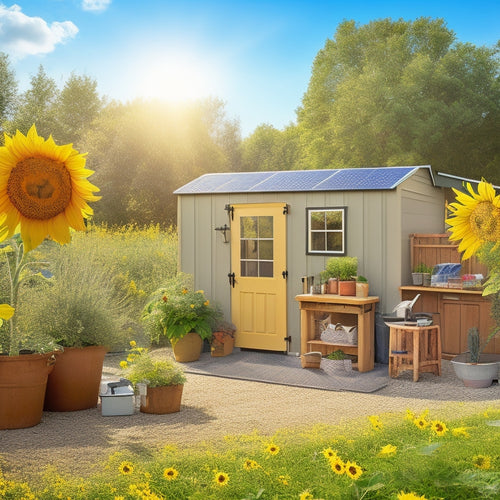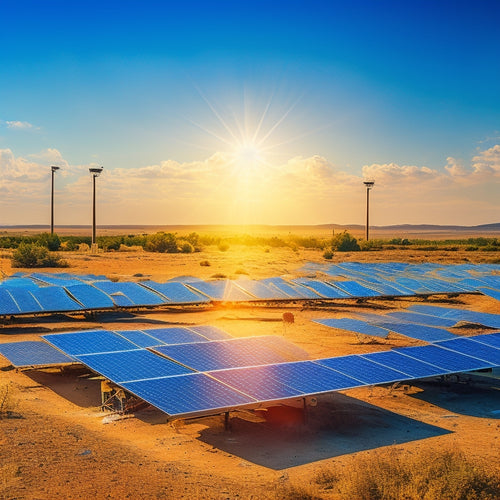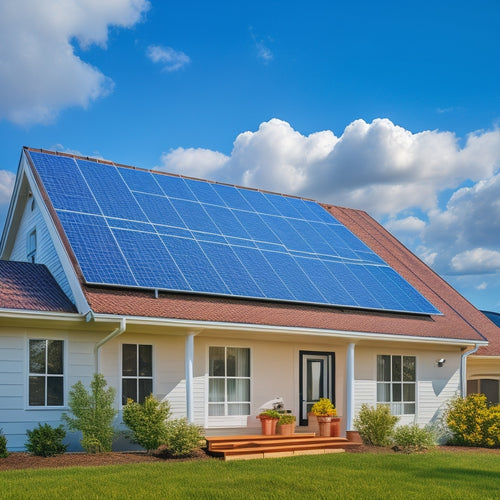
Home Solar Power Kit
Share
You're taking a significant step towards energy independence by considering a home solar power kit, which can reduce your reliance on the grid, lower your utility bills, and increase your property value. On average, homeowners save $400 to $1,000 annually by switching to solar, and 80% of American households can save hundreds annually. To maximize energy savings, you'll need to assess your daily energy consumption patterns, choosing a high-efficiency solar panel setup that optimizes sunlight capture. Getting the right kit requires understanding your energy needs, and by doing so, you'll be well on your way to utilizing the full benefits of solar power.
The Essentials
- A home solar power kit reduces energy costs by $400 to $1,000 annually, depending on current energy consumption and system size.
- Solar power kits increase property value by up to 17% and enhance home desirability with rising demand for renewable energy solutions.
- High-efficiency monocrystalline silicon cells (18-22% efficiency) maximize energy independence and investment value, outperforming polycrystalline and thin-film cells.
- A home solar power kit's power output capacity must match daily energy needs, considering peak usage hours and energy storage for excess energy.
- Optimal solar panel setup requires a 30-40 degree angle, facing the sun without obstructions, and assessment of potential shading for maximum energy utilization.
Cut Energy Bills Now
You can considerably slash your energy costs by utilizing the power of the sun.
With a reliable solar panel and battery kit, you'll have a backup power source during frequent outages, ensuring that essential appliances and devices remain functional.
By installing a home solar power kit, you'll reduce your reliance on the grid and lower your utility bills.
This not only saves you money but also reduces your carbon footprint, contributing to a cleaner environment.
Slash Your Energy Costs
Roughly 80% of American households can expect to save hundreds of dollars annually by switching to solar power. You're likely one of them. By installing a home solar power kit, you'll greatly reduce your energy costs.
The amount you'll save depends on factors like your current energy consumption, the size of your solar panel system, and the available solar incentives in your area. With the ability to capture and store excess energy generated by your solar panels during the day, you can power your home at night or during power outages without incurring additional costs home energy storage.
Additionally, by switching to a home solar power battery, you'll enjoy reduced energy expenses, uninterrupted power supply, and the freedom to be less reliant on the grid. On average, homeowners who switch to solar power save between $400 and $1,000 per year on their energy bills.
These energy savings can add up quickly, allowing you to recoup your initial investment in a relatively short period. Plus, with the current solar incentives, such as the 26% federal tax credit, you can offset a considerable portion of your upfront costs.
Reduce Your Carbon Footprint
Switching to a home solar power kit not only slashes energy costs but also considerably reduces your carbon footprint. This is a significant step towards sustainable living, as you'll be relying on a renewable energy source to power your home.
By utilizing the sun's energy, you'll decrease your reliance on fossil fuels, which are a major contributor to greenhouse gas emissions. With the ability to store excess energy in battery storage systems, you'll have a reliable backup power source during outages and emergencies.
You'll be doing your part to combat climate change and preserve the planet's natural resources for future generations. Adopting eco-friendly practices like solar power not only benefits the environment but also enhances your reputation as a responsible citizen.
As you cut down on your carbon emissions, you'll be contributing to a cleaner, healthier environment. With a home solar power kit, you'll enjoy the freedom to generate your own energy, reduce your dependence on the grid, and live a more sustainable lifestyle.
Increases Property Value Fast
You'll be pleased to know that installing a home solar power kit can greatly enhance your property's resale value fast.
In fact, it can increase your home's worth by up to 17% according to the National Renewable Energy Laboratory.
With the rising demand for renewable energy solutions, homeowners are now more than ever looking for ways to reduce their electricity costs and carbon footprint.
This means you'll not only save money on energy bills but also reap the benefits of a higher property value when you decide to sell.
Boosts Resale Value Fast
Installing a home solar power kit can greatly enhance your property's resale worth fast, as it becomes a highly desirable feature for potential buyers.
As you consider investing in a solar power kit, you'll want to know that it can notably increase your property's resale worth. In fact, according to current solar market trends, properties with solar installations sell faster and for higher prices than those without.
A property appraisal will likely reflect the added worth of your solar power kit. This is because solar installations are seen as an important asset, reducing energy costs and increasing the overall appeal of your property.
By installing a solar power kit, you can differentiate your property from others on the market, making it more attractive to potential buyers. This can lead to a faster sale and a higher sale price, ultimately enhancing your resale worth.
With the increasing demand for sustainable and energy-efficient homes, investing in a solar power kit can be a smart move for homeowners looking to maximize their property's resale worth.
Increases Home Worth
Frequently, homeowners who invest in a home solar power kit experience a significant surge in their property's value. This increase in value directly translates to an enhancement in your home equity, providing you with more financial freedom and security.
As you reap the investment benefits of your solar power kit, you'll be able to tap into your increased home equity for future loans or projects.
You'll find that your solar-powered home becomes more attractive to potential buyers if you decide to sell in the future. This is because homebuyers are willing to pay a premium for homes with solar panels, which can lead to a faster sale and a higher selling price.
In fact, studies have shown that solar panels can increase your property value by up to 17%. This significant increase in value can be a major selling point, setting your home apart from others on the market.
Monocrystalline Silicon Cells
You'll want to evaluate the cell efficiency rate of monocrystalline silicon cells, which can reach up to 22% or more, making them a top choice for home solar power kits.
These high-efficiency cells also offer a higher power output capacity, allowing you to generate more electricity from a smaller surface area, which is essential for residential solar panel systems that require maximum energy savings.
Additionally, the higher power output capacity of monocrystalline silicon cells can lead to lower energy bills and a faster return on investment for your home solar power kit.
With these advantages, monocrystalline silicon cells can greatly influence the overall performance of your solar power system.
Cell Efficiency Rate
Your home solar power kit's performance hinges on the cell efficiency rate of its monocrystalline silicon cells. As you consider utilizing solar technology, understanding the efficiency rate is vital. It measures how well the cells convert sunlight into electricity.
| Cell Type | Efficiency Rate |
|---|---|
| Monocrystalline Silicon | 18-22% |
| Polycrystalline Silicon | 15-18% |
| Thin-Film | 7-14% |
Efficiency advancements in monocrystalline silicon cells have markedly improved their performance. Manufacturers have achieved higher efficiency rates through innovative designs and materials. For instance, some high-efficiency cells can reach up to 23% efficiency. This means more power output per unit area, making them ideal for residential solar installations. When selecting a home solar power kit, look for high-efficiency cells to maximize your energy independence.
Power Output Capacity
With monocrystalline silicon cells boasting high efficiency rates, their power output capacity becomes an important aspect to take into account in your home solar power kit.
When selecting solar panel types, you'll want to take into account the power output capacity to guarantee it meets your energy needs. A higher power output capacity means more electricity generated, but also increases the installation process complexity and cost.
When sizing your system, think about your energy storage needs, as excess energy can be stored for later use.
Maintenance tips, such as regular cleaning, can also impact power output capacity. Inverter options play a vital role in converting DC power to AC, and choosing the right one can optimize your system's performance.
Grid connection and monitoring systems allow you to track your energy production and consumption, while warranty considerations provide peace of mind.
Assess Your Energy Usage
You'll need to determine your daily energy consumption to size your solar power kit correctly.
To do this, you'll want to examine your energy usage patterns, including the times of day when you use the most power. By understanding your energy habits, you can accurately calculate your energy needs and choose the right solar power kit for your home.
When selecting a solar power kit, it's crucial to evaluate renewable energy storage options, such as battery storage systems, to guarantee a reliable and efficient energy supply.
Daily Energy Consumption
Evaluating daily energy consumption is an essential step in determining the suitability of a home solar power kit. To do this, you'll need to assess your energy usage and identify areas where you can optimize your energy consumption. This involves conducting an energy audit, which will help you understand how much energy your home requires on a daily basis.
You can start by reviewing your past utility bills to identify your average daily energy consumption. This will give you a baseline to work from.
Next, you'll need to forecast your energy usage patterns, considering factors such as seasonal changes, appliance usage, and occupancy rates. This will help you determine the minimum energy requirements for your home.
Energy Usage Patterns
Your energy usage patterns play a significant role in determining the size and type of home solar power kit you need. To accurately assess your energy usage, you'll need to understand your energy patterns and usage trends.
Start by identifying your peak energy usage hours, which are typically during the day when lights, appliances, and electronics are in use. You should also consider your energy usage during the night when lights, refrigerators, and HVAC systems are still running.
Analyzing your energy usage patterns will help you determine the required capacity of your solar power kit. For instance, if you have a high energy demand during the day, you'll need a larger solar panel array to meet that demand.
On the other hand, if your energy usage is more spread out throughout the day, a smaller array might be sufficient. By understanding your energy patterns and usage trends, you can optimize your home solar power kit to meet your specific energy needs and maximize your energy independence.
Higher Efficiency Rate Guaranteed
You'll want a home solar power kit that guarantees a higher efficiency rate, as it directly translates to maximum energy harvested.
A higher efficiency rate assures that your system captures the most energy from the sun, reducing your reliance on the grid.
With a higher efficiency rate, you'll be producing more power per hour of sunlight, making the most of your investment.
Maximum Energy Harvested
Utilizing maximum energy from the sun is vital to justify the investment in a home solar power kit. You want to ascertain you're getting the most out of your solar panels, and that means optimizing their performance.
To achieve maximum energy harvested, you'll need to reflect on two important factors: solar panel orientation and sunlight exposure.
When it comes to solar panel orientation, you'll want to position them at an angle that allows them to capture the most sunlight throughout the day. This typically means installing them at a tilt between 30-40 degrees, depending on your location and the time of year.
Additionally, you'll want to verify they're facing directly at the sun, without any obstructions or shading.
Sunlight exposure is also essential, as it directly affects the amount of energy your solar panels can produce. You'll want to choose a location that receives direct sunlight for the majority of the day, considering any potential shading from trees, buildings, or other obstacles.
Frequently Asked Questions
Can I Install a Home Solar Power Kit Myself?
You can attempt a DIY installation, but consider your electrical proficiency and ability to handle solar kit components, such as panels, inverters, and mounting systems, before deciding to go solo.
Are Solar Panels Damaged by Heavy Snowfall or Hail?
You're right to wonder: heavy snowfall and hail can be brutal. Fortunately, most solar panels are designed to withstand snow damage and are built with hail resistance in mind, so you can rest easy knowing your investment is protected.
Do Solar Panels Work During Power Outages?
When the grid goes down, you'll find that solar panels don't automatically provide power, as they're designed to sync with the grid for safety and efficiency; however, with a proper grid connection and backup system, you can maintain solar panel efficiency during outages.
Can I Add More Panels to My Existing Kit Later?
Did you know 70% of homeowners consider solar panel expansion within 5 years? You can add more panels to your existing system later, as long as you guarantee panel compatibility and factor in installation costs, giving you the freedom to generate more clean energy.
Will Solar Panels Affect My Roof's Warranty?
When you install solar panels, you're concerned about roof integrity and warranty coverage. You'll want to check with your roofing manufacturer to guarantee the installation won't void your warranty, as some may have specific requirements or restrictions.
Final Thoughts
You've made the smart decision to invest in a home solar power kit. Cut energy bills now and increase your property value fast. With monocrystalline silicon cells, you're guaranteed a higher efficiency rate. Assess your energy usage to maximize your kit's potential. Did you know that the average American homeowner saves around $500 per year on electricity bills by going solar? That's a significant chunk of change back in your pocket, and a great reason to make the switch.
Related Posts
-

Building an Emergency Backup Solar Power System in 5 Essential Steps
Building an emergency backup solar power system involves five key steps. First, assess your daily energy needs to ide...
-

What Happens Without a Charge Controller in Solar Panels
Without a charge controller in your solar panel system, you risk overheating batteries due to overcharging, which can...
-

Cost of Solar Panel Installation
You can expect to pay between $15,000 and $30,000 or more for a typical solar panel installation, depending on the sy...


